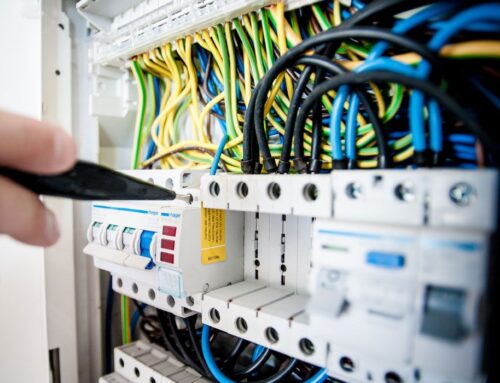Distributed controller system (DCS) is an electronic interface for monitoring and operating plants or manufacturing processes. A DCS consists of: a human-machine interface (HMI), a logical approach to solving a shared database, an alert control system, and a standard engineering suite. DCS is not only used for all advanced control techniques today but also for low-level control loops. A developing method has been carried out and is still emerging by introducing automated process management. The plants used the local, large-scale pneumatic controls at first. The control panels and the consoles later became miniaturized and standardized with DCS. When analog electronic instruments were introduced, their appearance changed to a small extent. In a single platform, a modern distributed control system unifies unique capabilities in independent, separate entities. The DCS is also a monolithic system, with power spread throughout the plant through private networks that originated as 4-20mA signals on twisted cables. The conventional DCS system is a single system. Over the years, software, hardware, and networks have become more modern, digital, and efficient, but regulation in network protocol and device wheelbarrows has been carried out with few exceptions. It is a smart idea to study advances in control systems to understand DCS. This includes hardware components, the theory of device implementation, and the drivers behind this development. It helps one understand how the regulation, knowledge flow, and decision-making of systems have changed over the years.
A Modern DCS is Essential for Digital Transformation
An update to a new DCS digital transformation strategy will help you maximize effectiveness and decreasing risk. The dynamics and difficulties of keeping competitive are faced by suppliers and manufacturers of industries from pharmaceuticals, consumables, food, beverages, and mining and chemical industries. Profits are secured, and productivity is optimized with enhanced performance, decreased downtimes, consistency, quality sustained, and jobs safeguarded. It is often essential to consider the lifecycle costs involved with manufacturing, inventory, and system repair and service. Given the ongoing global pandemic, this is especially important. The need for quality and productivity, thus reducing organizational risk, is evident by using modern DCS. It can be challenging to keep up with the market and technology innovations yet to push activities to the next stage to thrive and succeed. Technologies from the Industrial Internet of Things (IIoT) will help. A digital development approach is a successful starting point.
Time for an update to the DCS:
In a conventional DCS, the system is locked, challenging to migrate and modify, and has significantly higher ownership costs in the majority of cases. For several reasons: improved performance, location-wide flexibility, scalability, the open technology stack, and ease of integration, modern DCS is preferable. With standard automation equipment, a plantwide control system can be combined smoothly with the construction site and commercial structures for process control, discernment control, power control, and security checks. You’re not alone if you feel your DCS has run its course. The near-end of the life of the global DCS installed base is roughly US$65 billion. And there are lots of them. Reasons for substituting a DCS may include an increased failure rate, improved product quality concerns, accelerated repair costs, lack of conventional DCS experience, restriction of capability, and inability to communicate with modern systems.
Modern DCS in action:
The pharmaceutical industry used a modern DCS to automate its bioprocessing methods and provide internet connectivity by combining an application and electronic batch data manufacturing system (MES). Consequently, the production, supply, and productivity have improved by 10 to 20 percent, and energy usage, raw materials, batch release time, repairs, and downtime have dropped by 5 to 30 percent. In another case, a food and beverage corporation wanted its processes to be expanded and its automation system updated. Since introducing a new DCS, the organization experienced a 20% growth in capability in just one year. The present access real-time data offers permanent connectivity so that workers can make rational flying decisions instantly.
The benefits of modern DCS:
The new DCS features have kept pace with advances in technology. As part of the digital transformation plan, a modern DCS will help create a connected organization. These systems can minimize architectural footprint by decreasing servers and powerful controllers, enhancing compatibility in the computer with native process artifacts, simplifying the workflows with enhanced device attributes architecture expertise, and providing rigorous insight into making real-time decisions in real-time with global cybersecurity requirements. This ensures that a new DCS can help manufacturers gain plantwide monitoring and optimization, updated operations, and achieve high availability. Essentially, it simplifies life. It also tackles three main obstacles that manufacturers and retailers face almost globally:
- Operational risk control:
Risk is all around us, and in many aspects, it is the cornerstone of the system, the network infrastructure. Unpredicted circumstances may have an impact on secure and efficient plant operations even though contingencies are considered. If you identify variables leading to different risk situations, you need applications to manage and respond actively armed to knowledge in tricky conditions. When risks transfer to external causes from organizational danger, mechanisms of management must be robust but adaptable.
- Improved efficiency:
How do you adapt better as various processes build bottlenecks and shortfalls around the company? The vast amount of knowledge from supply chains, plant assets, and business systems will confuse teams attempting to operate or implement a new idea in real-time. Rapid technical advances allow producers to access more knowledge for decision-making purposes than ever before.
- Do more for less to support the end:
Manufacturing departments must do better to fulfill revenue targets over the entire lifespan of their plant. Your operations have to obtain the exposure and power to minimize unplanned downtimes, avoid quality failures and eradicate waste. Manufacturers seek factory-wide automation that is upgraded and assisted effectively, and equipment needs to help the plant continue to operate.
Final Words:
Digital transformation is not gone – every maker and producer must start their journey at some point. It is known as the current standard for many producers. Digital transformation is at its highest level a cornerstone for manufacturing and is theoretically a progressive growth. Using emerging technology will change the way of doing business radically. Assess your legacy infrastructure to see how your digital transformation path will benefit from the new DCS program.



